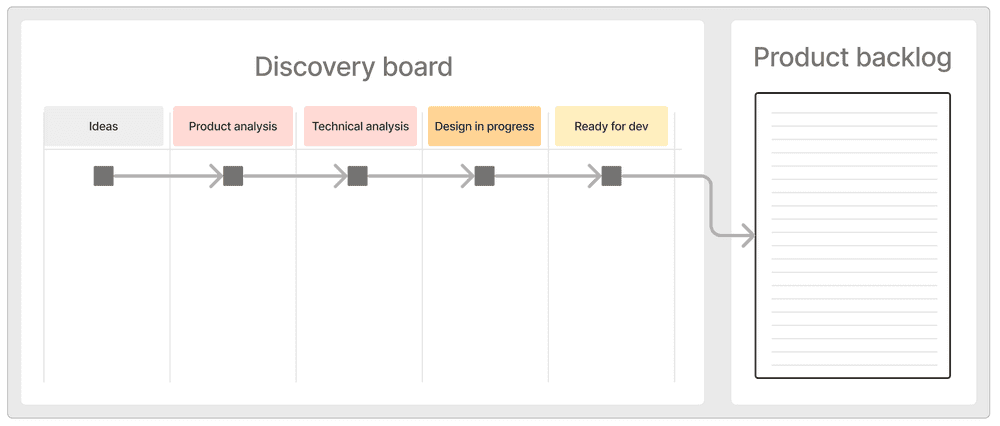What is a discovery Kanban board?
A discovery Kanban board is a visual representation of the discovery phase, following the same Kanban framework often used for development. While a development Kanban board tracks the workflow across columns like "Ready for dev," "In Development," "Merge Review," and "Ready for Test," a discovery Kanban board has columns such as "Ideas," "Product analysis," "Technical analysis," "Design in progress" and "Ready for dev." The outputs of the discovery Kanban board form the product backlog, ensuring that backlog items meet a defined standard of readiness.
 Example discovery workflow
Example discovery workflow
Increased cross-functional collaboration
The discovery board serves as a hub for collaboration among key stakeholders, including designers, business analysts/product managers, and tech leads. As an idea moves through the workflow, each team contributes their unique perspectives. The workflow and stakeholders involved may vary depending on the nature of the product, client needs, and organisational structure. To ensure that all parties' needs are met, the discovery Kanban process should be tailored and agreed upon by the entire project team.
In the example Kanban board pictured above:
- Product team members generate initial ideas and validate requirements based on market research, customer feedback, and business goals.
- Tech leads provide input on technical feasibility and architectural implications, helping to identify potential roadblocks or alternative approaches early in the process.
- Designers work closely with the product team to translate validated requirements into compelling user experiences and visual designs, ensuring that the final product meets functional needs and delivers a delightful user interface.
This collaborative approach ensures that by the time an initiative reaches the "Ready for dev" column, it has been thoroughly vetted, designed, and optimised for successful implementation.
Integrating the discovery board with development
The beauty of the discovery kanban lies in its seamless integration with the existing development process. As this process is a precursor to the development process, the only difference the development teams should notice is an increased quality and consistency to the items making up their backlog. From there, the development team can pick up the well-defined requirements and visual designs, confident that the groundwork has been laid and the initiative has been thoroughly vetted and conceptualised.
Benefits of a discovery Kanban
- Prioritisation: By visualising the upcoming and work in progress, the Kanban board helps the team prioritise tasks more effectively, ensuring that the most important work is tackled first.
- Collaborative refinement and design: The discovery board fosters cross-functional collaboration, ensuring that requirements are thoroughly analysed from multiple perspectives and that the visual design and user experience are well-conceived before moving forward.
- Consistent product backlog standards: The discovery board process ensures that all items entering the development backlog have met the same set of standards, undergoing thorough analysis, technical validation, and design.
- Visualised progress: With many items being explored, validated, and reworked, discovery boards allow for easy visualisation of progress and workload on team members.
Conclusion
Implementing a discovery Kanban board separates the ideation, validation, and design stages from the actual development work, ensuring that your development team is always working on high-quality, well-defined backlog items. By bringing a set structure, and increased efficiency and collaboration to the product development process, a discovery Kanban board can significantly improve the overall quality and success of product initiatives.
In upcoming posts, we’ll be delving into this in more detail, looking at Jira configurations to support this process, and examining what really makes an item “Ready for dev.”